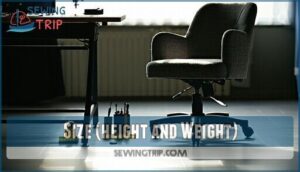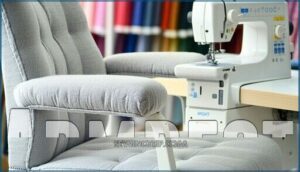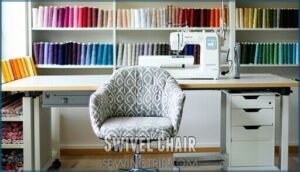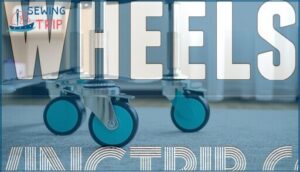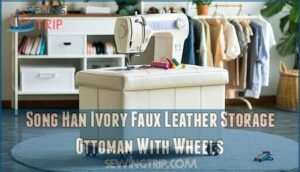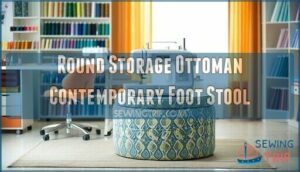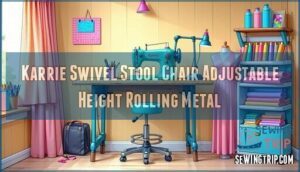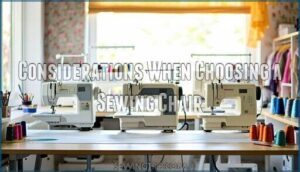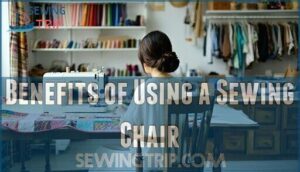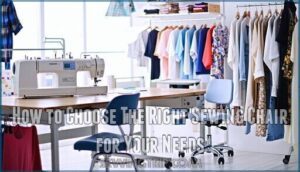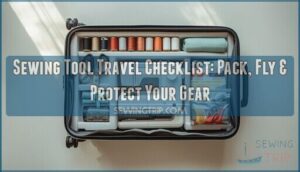This site is supported by our readers. We may earn a commission, at no cost to you, if you purchase through links.
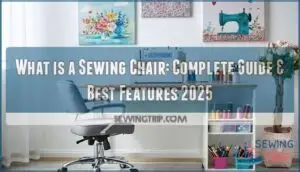
Most sewing chairs include rolling wheels and swivel bases, so you can glide between your cutting table and machine without missing a beat. Many models offer built-in storage compartments that keep scissors, thread, and notions within arm’s reach.
Unlike regular office chairs, sewing chairs are compact enough to tuck under your table when not in use, making them perfect for smaller craft rooms. The right sewing chair transforms your workspace from a pain-inducing struggle into a comfortable, organized haven where creativity flows freely.
Table Of Contents
Key Takeaways
- You’ll get proper support through adjustable heights (18-22 inches) and ergonomic backrests that prevent spine pain during long sewing sessions.
- You can move freely around your workspace with rolling wheels and 360-degree swivel bases, eliminating awkward stretching and repositioning.
- You’ll keep supplies organized with built-in storage compartments for thread, scissors, and notions right within arm’s reach.
- You can use these versatile chairs for other crafts like quilting, embroidery, and knitting since they’re designed for detailed work requiring prolonged sitting.
Features of a Sewing Chair
You’ll find that the right sewing chair features can transform your crafting sessions from uncomfortable struggles into productive, pain-free experiences.
The right sewing chair transforms uncomfortable crafting struggles into productive, pain-free experiences
Key elements like adjustable height, proper back support, armrest options, swivel capability, and mobility wheels work together to create an ergonomic workspace that bolsters your body during long sewing projects.
Size (height and Weight)
Most sewing chair features depend on getting the size right. Chair height and adjustable range matter because your feet should rest flat on the floor while your thighs stay parallel to it. Weight capacity affects stability – you’ll want chairs supporting at least 250 pounds for durability. Space constraints in your sewing room determine whether you need compact storage options or can accommodate larger designs.
- Adjustable height ranges commonly span 18-22 inches to match various table heights and user preferences
- Weight capacity varies from 200-400 pounds, with higher limits providing better long-term stability
- Compact storage designs fold or nest under tables when available space is limited
- Sewing chair features like pneumatic lifts make certain smooth height adjustments without wobbling during use
Backrest
Your backrest can make or break your sewing experience. After considering chair height and weight capacity, the ergonomic back support becomes your spine’s best friend during those marathon quilting sessions.
| Feature | Basic Backrest | Premium Backrest |
|---|---|---|
| Lumbar Support | Fixed position | Adjustable height zones |
| Material | Rigid plastic | Mesh material with flex |
| Backrest Angle | Static upright | Tilt adjustment range |
| Contoured Design | Flat surface | Curved back following spine |
| Support Duration | 1-2 hours comfortable | All-day comfort rating |
Look for adjustable height positioning that aligns with your natural spine curve. Mesh material offers breathability while maintaining firm support. The contoured design should cradle your lower back without forcing awkward positioning.
Armrest
When considering armrests for your sewing chair, you’ll find they can make or break your comfort during long stitching sessions. Adjustable armrests offer the best value, letting you customize height and width to match your body perfectly. This adjustable height feature prevents shoulder strain and bolsters natural arm movement while you guide fabric through your machine.
Armrest Materials matter too. Padded comfort from memory foam or cushioned fabric beats hard plastic every time. Some sewists prefer no armrests entirely – this armrest style gives complete arm movement freedom when working with large quilts or bulky projects.
Ergonomic Benefits include proper wrist alignment and reduced muscle tension. Here’s what to look for:
- Flip-up or removable armrests that get out of your way when needed
- Width adjustment to accommodate different body types and sewing stances
- Soft padding that won’t dig into your forearms during extended use
Different Armrest Styles work for different sewists. Traditional fixed armrests provide consistent support, while adjustable armrests adapt to various tasks.
Swivel Chair
Freedom of movement transforms your sewing experience. A quality swivel chair rotates 360 degrees, letting you pivot effortlessly between your cutting table and machine without awkward twisting.
Modern swivel mechanics feature ball bearings for smooth rotation range and stability features that prevent unwanted spinning during focused work.
Ergonomic swivel chairs combine this mobility with proper support, while swivel durability depends on quality construction. Unlike fixed ergonomic chairs, swivel sewing chairs adapt to your workflow.
Choose chairs for sewing with reliable swivel mechanisms that boost productivity without sacrificing the ergonomic benefits you need.
Wheels
Rolling wheels transform your sewing chair into a mobile workstation. Look for locking casters that secure your position during precision work.
Wheel durability matters – quality materials like nylon or polyurethane offer smooth rolling across hardwood and carpet compatibility. Hard wheels work best on carpets, while soft wheels glide smoothly on hard floors.
Choose wheels that match your workspace for peak mobility.
Different Types of Sewing Chairs
You’ll find several distinct sewing chair styles available, each designed to meet specific workspace needs and comfort preferences.
Understanding these different types helps you select the chair that best bolsters your sewing posture and betters your productivity during long crafting sessions.
Song Han Ivory Faux Leather Storage Ottoman With Wheels
The Song Han Ivory Faux Leather Storage Ottoman with Wheels transforms your sewing room into an organized workspace. This adaptable sewing chair combines comfortable seating with hidden storage capacity for your sewing supplies.
Its ottoman durability comes from quality construction supporting 200-300 pounds. The rolling mechanism features smooth-gliding wheels that move effortlessly across floors. Faux leather care is simple—just wipe clean after use.
Color variations beyond ivory let you match your decor. Storage options include a spacious compartment beneath the cushioned seat. Assembly takes minutes without tools, making it perfect for busy sewists. These ottomans offer dual functionality options to get the most out of space.
Round Storage Ottoman Contemporary Foot Stool
Looking beyond leather storage options, the Round Storage Ottoman Contemporary Foot Stool brings exceptional Round Ottoman Versatility to your sewing room. This Space Saving Solution doubles as extra seating while providing hidden storage solutions for sewing supplies.
The Ottoman Storage Capacity accommodates notions and fabrics efficiently. Contemporary Design Trends favor its compact profile, maximizing workspace without sacrificing Foot Stool Comfort during long projects.
Baxton Studio Aleron Ottomans Pink Gold
When style meets storage solutions, Baxton Studio Aleron Ottomans Pink Gold delivers both aesthetic appeal and Ottoman Versatility. The velvet upholstery with gold-finished metal base adds Studio Quality glamour to your sewing room decor.
You’ll appreciate the removable plush cushion that provides Seating Comfort while accessing hidden storage options underneath. This Aleron Design perfectly balances fashionable pink gold aesthetics with practical storage solutions for organizing sewing supplies.
Karrie Swivel Stool Chair Adjustable Height Rolling Metal
The Karrie swivel stool chair adjusts from 18-24 inches, making it perfect for varying table heights. This rolling metal design holds up to 400 pounds while offering complete 360-degree mobility around your workspace.
Key Features:
- Swivel Stool Benefits: Complete rotation access to materials without getting up
- Adjustable Height Advantages: Customizable positioning for proper ergonomic alignment
- Rolling Metal Durability: Heavy-duty construction withstands daily sewing room movement
- Karrie Chair Uniqueness: Water-resistant upholstery simplifies cleanup after messy projects
Unlike traditional sewing chairs with backrests, this stool provides unrestricted upper body movement for detailed work.
Considerations When Choosing a Sewing Chair
When you’re shopping for a sewing chair, you’ll need to balance several key factors that directly impact your comfort and productivity. The right chair should match your specific sewing habits, workspace dimensions, and budget while offering the ergonomic support your body needs during long crafting sessions.
Comfort
Beyond chair types, comfort level becomes your top priority when choosing the right ergonomic sewing chair. Your body will thank you during those marathon quilting sessions when you’ve got proper seat cushioning and lumbar support working together.
Consider these comfort fundamentals:
- Seat cushioning – Memory foam or high-density padding prevents pressure points
- Breathability – Mesh backs keep you cool during extended projects
- Posture alignment – Adjustable height matches your sewing table perfectly
The best sewing comfort comes from chairs that adapt to you, not the other way around. Look for increased comfort through customizable features like adjustable armrests and backrest angles. Your spine’s natural curve needs consistent support, and pressure relief becomes critical after hour three of intricate stitching.
Storage Options
Comfort comes first, but storage options make your sewing chair truly functional. Smart storage solutions keep supplies within arm’s reach while you work.
- Hidden compartments under the seat store thread organizers and portable caddies
- Integrated drawers hold pins, needles, and small tools for quick access
- Ottoman storage provides extra space for fabric scraps and project materials
Efficient organization transforms your sewing experience from chaotic to well-ordered.
Design and Aesthetics
Your chair’s design and aesthetics matter more than you think. Chair Color sets the mood for your workspace – calming blues sharpen focus while vibrant yellows spark creativity. Fabric Choice affects both looks and function. Smooth vinyl wipes clean easily, while textured upholstery adds visual interest.
Style Evolution has brought us from basic wooden stools to sleek Modern Aesthetics with clean lines and minimalist forms. Some crafters prefer Vintage Designs that echo traditional sewing rooms.
Consider how Fabric Designs complement your space – florals suit cottage-style rooms, geometric patterns work in contemporary settings. Smart material selection balances aesthetic appeal with practical needs.
Material and Durability
When selecting material for your sewing chair, you’re investing in years of comfortable crafting sessions. The right material selection directly impacts both durability and your daily sewing experience.
Frame strength forms the backbone of any quality sewing chair. Look for solid metal construction rather than plastic components, as these prevent wobbling and extend the chair’s lifespan considerably. Quality frames support 300-500 pounds, reflecting sound engineering.
Consider these key material factors:
- Upholstery durability – Choose fabrics rated 2-5x more durable than standard office chairs, with anti-pilling properties
- Cushion resilience – High-density foam maintains shape with less than 5% compression over its lifetime
- Stitch quality – Reinforced seaming prevents fabric separation during regular use
- Fabric lifespan – Stain-resistant, colorfast materials maintain appearance despite frequent use
Long-term wear resistance matters more than initial appearance. Breathable mesh or easy-to-clean fabrics increase comfort while resisting breakdown. A good option is a chair with adjustable armrests, allowing for individualized support. Well-constructed sewing chairs often include warranties, reflecting manufacturer confidence in material durability.
Assembly and Maintenance
When selecting sewing chairs, assembly and maintenance matter more than you’d think. Initial Assembly should be straightforward with clear instructions and minimal hardware. Look for chairs requiring basic tools only.
Routine Cleaning becomes simple with removable, washable covers. Regular Hardware Checks prevent wobbly seats mid-project.
Part Replacement availability ensures Long-Term Care. Smart assembly and maintenance choices keep your sewing chair reliable for years.
Benefits of Using a Sewing Chair
You’ll experience significant improvements in comfort and posture when you switch from a regular chair to a purpose-built sewing chair.
These specialized chairs reduce back strain, prevent fatigue during long sessions, and provide the proper support your body needs for extended sewing projects.
Improved Posture and Ergonomics
Your spine deserves better than hunching over your sewing machine for hours. A proper sewing chair with ergonomic design bolsters spinal alignment and reduces muscle strain naturally. Smart ergonomic adjustments help you maintain improved posture throughout long sessions:
- Built-in lumbar support cradles your lower back’s natural curve
- Adjustable seat height aligns your spine with your work surface
- Contoured backrest promotes proper shoulder positioning
- Ergonomics training becomes automatic with consistent support
Increased Comfort and Reduced Fatigue
Long sewing sessions can feel like a marathon without proper support. An ergonomic sewing chair delivers increased comfort through specialized posture support that reduces muscle strain throughout your body.
Memory foam cushioning and lumbar alignment prevent the aches that commonly emerge after extended session length.
Better circulation improvement keeps your legs from going numb, while reduced fatigue means you’ll finish projects feeling energized rather than exhausted.
Enhanced Mobility and Accessibility
Beyond comfort, mobility transforms your sewing experience. Rolling wheels and a swivel base let you glide between tasks without standing. Here’s how enhanced accessibility boosts your productivity:
- Workspace Navigation – Move freely around cutting tables and storage areas
- Reach Optimization – Access supplies without stretching or straining
- Posture Adjustment – Find your perfect angle for different sewing techniques
- Task Switching – Roll between machines, ironing boards, and work surfaces
A swivel chair with wheels reduces fatigue by eliminating awkward movements. You’ll spend more time creating and less time repositioning yourself.
Efficient Organization and Storage
Moving from better accessibility to smart storage solutions, your sewing chair becomes a real asset for workspace optimization. The right sewing chair transforms how you handle sewing supplies through integrated storage features that keep everything within arm’s reach.
Smart storage options include:
- Thread Management: Built-in spool holders and thread organizers prevent tangled messes
- Pattern Storage: Dedicated compartments for folded patterns and instruction sheets
- Accessory Organization: Pockets for scissors, seam rippers, and measuring tools
- Supply Compartments: Hidden storage for pins, needles, and small notions
- Document Holders: Clips or slots for keeping active project notes visible
These storage solutions create efficient organization systems that reduce time spent searching for tools. You’ll spend more time creating and less time hunting through cluttered drawers.
Versatility and Multi-functionality
Your sewing chair transforms into the best workspace companion through its impressive multifunctionality. Beyond efficient organization, these adaptive seating solutions excel in crafting applications from embroidery to scrapbooking.
Space optimization becomes simple when your chair doubles as home office seating for computer work or reading. Multi-craft use extends storage solutions beyond sewing supplies to art materials and office supplies.
| Application | Storage Feature | Space Benefit |
|---|---|---|
| Sewing Projects | Built-in compartments | Reduces clutter |
| Home Office Work | Document storage | Maximizes efficiency |
| Multi-Craft Use | Tool organization | Streamlines workflow |
How to Choose The Right Sewing Chair for Your Needs
You’ll need to match your chair to your sewing setup, body measurements, and daily habits to find the perfect fit.
Consider your table height, the hours you spend sewing, and whether you need storage space or mobility features before making your decision.
Assess Your Specific Sewing Requirements
Understanding your sewing requirements helps you find the perfect sewing chair. Consider task frequency and project types you tackle most often. Quilters need different sewing comfort than garment makers.
Evaluate your posture needs and any physical limitations. Do you experience back pain during long sewing sessions?
Factor in budget constraints while prioritizing features that match your specific sewing tasks and projects.
Consider Your Workspace and Available Space
Your sewing room dimensions determine which chair will work best for your crafting space. Measure your workspace dimensions carefully before shopping. Check that your chosen sewing chair’s footprint fits comfortably around your sewing table without blocking walkways. Consider storage integration needs and accessibility requirements for your sewing workspace.
- Measure doorways – Make certain your chair can pass through all access points to your sewing room
- Check table clearance – Verify the chair tucks under your sewing surface when not in use
- Plan movement space – Allow room for rolling and swiveling during layout optimization
Determine Your Budget
Budget constraints shouldn’t derail your sewing chair selection process. Start by setting a realistic spending limit that reflects your long-term investment goals.
Feature prioritization becomes key when working within budget limits. Focus on essential elements like adjustable height and lumbar support over fancy extras.
Payment options and DIY alternatives can stretch your dollars further. Quality sewing chairs exist at every price point when personal preference guides smart shopping decisions.
Test The Chair for Comfort and Functionality
Before purchasing, test the chair for comfort and functionality. Sit in your potential sewing chair for at least fifteen minutes to conduct a proper Ergonomic Assessment.
Check how your spine aligns with the backrest for ideal Posture Alignment. Notice any Pressure Points that develop during Extended Use.
Test your Motion Range by reaching forward and sideways as you’d while sewing. An ergonomic chair should feel comfortable immediately, not after a "break-in period.
Frequently Asked Questions (FAQs)
What is the ideal sewing chair height?
Ironically, you’d think any chair works for stitching, but your ideal height sits 18-22 inches, matching your elbow angle when arms rest naturally at your sides.
Can sewing chairs work with any table?
You’ll need to check table height compatibility first. Most sewing chairs adjust from 18-22 inches, but your table’s height matters most for proper ergonomics and comfort.
Do sewing chairs require special assembly tools?
Like your great-grandmother’s Singer treadle, most sewing chairs come ready-to-use.
You’ll usually need basic tools like a screwdriver and Allen wrench that manufacturers include. Assembly takes 20-30 minutes max with straightforward instructions.
How much should I spend on sewing chairs?
Budget $150-400 for a quality sewing chair that’ll support your posture and projects. You’ll find decent ergonomic options around $200, while higher-end models with greater adjustability reach $350-
Are sewing chairs suitable for other crafts?
You’ll find sewing chairs work great for embroidery, quilting, knitting, and crafts. Their ergonomic design, adjustable height, and lumbar support benefit any detailed work requiring prolonged sitting.
Conclusion
Like finding the perfect dance partner, discovering what’s a sewing chair means making creativity flow in your craft room. You’ve learned that these specialized seats combine ergonomic support, adjustable heights, and smart storage solutions to transform your sewing experience.
The right sewing chair eliminates back pain, keeps supplies organized, and lets you glide effortlessly around your workspace. Whether you choose a storage ottoman or adjustable stool, investing in proper seating means more comfortable hours creating beautiful projects.
- https://arrowsewing.com/blog/how-to-find-the-perfect-ergonomic-sewing-chair-for-you/
- https://www.reddit.com/r/sewing/comments/r66u40/vintage_sewing_chair/
- https://sewvacauthority.com/the-benefits-of-a-sewing-chair/
- https://topstitchsewing.net/collections/chairs
- https://www.stringandstory.com/blog/arrow-sewing-chair-review

